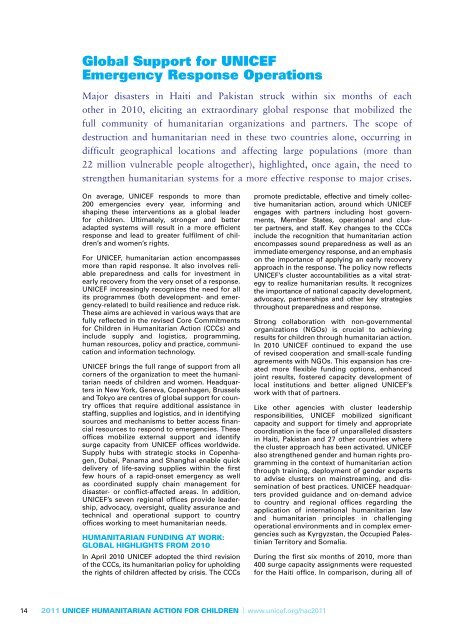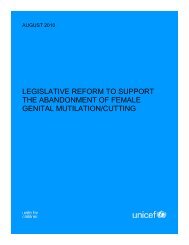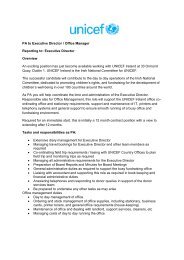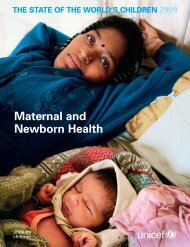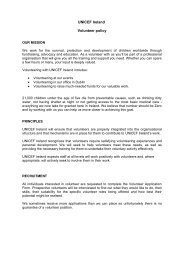Global Support <strong>for</strong> UNICEFEmergency Response OperationsMajor disasters in Haiti and Pakistan struck within six months of eachother in 2010, eliciting an extraordinary global response that mobilized thefull community of humanitarian organizations and partners. The scope ofdestruction and humanitarian need in these two countries alone, occurring indifficult geographical locations and affecting large populations (more than22 million vulnerable people altogether), highlighted, once again, the need tostrengthen humanitarian systems <strong>for</strong> a more effective response to major crises.On average, UNICEF responds to more than200 emergencies every year, in<strong>for</strong>ming andshaping these interventions as a global leader<strong>for</strong> children. Ultimately, stronger and betteradapted systems will result in a more efficientresponse and lead to greater fulfilment of children’sand women’s rights.For UNICEF, humanitarian action encompassesmore than rapid response. It also involves reliablepreparedness and calls <strong>for</strong> investment inearly recovery from the very onset of a response.UNICEF increasingly recognizes the need <strong>for</strong> allits programmes (both development- and emergency-related)to build resilience and reduce risk.These aims are achieved in various ways that arefully reflected in the revised Core Commitments<strong>for</strong> <strong>Children</strong> in <strong>Humanitarian</strong> <strong>Action</strong> (CCCs) andinclude supply and logistics, programming,human resources, policy and practice, communicationand in<strong>for</strong>mation technology.UNICEF brings the full range of support from allcorners of the organization to meet the humanitarianneeds of children and women. Headquartersin New York, Geneva, Copenhagen, Brusselsand Tokyo are centres of global support <strong>for</strong> countryoffices that require additional assistance instaffing, supplies and logistics, and in identifyingsources and mechanisms to better access financialresources to respond to emergencies. Theseoffices mobilize external support and identifysurge capacity from UNICEF offices worldwide.Supply hubs with strategic stocks in Copenhagen,Dubai, Panama and Shanghai enable quickdelivery of life-saving supplies within the firstfew hours of a rapid-onset emergency as wellas coordinated supply chain management <strong>for</strong>disaster- or conflict-affected areas. In addition,UNICEF’s seven regional offices provide leadership,advocacy, oversight, quality assurance andtechnical and operational support to countryoffices working to meet humanitarian needs.<strong>Humanitarian</strong> funding at work:Global highlights from 2010In April 2010 UNICEF adopted the third revisionof the CCCs, its humanitarian policy <strong>for</strong> upholdingthe rights of children affected by crisis. The CCCspromote predictable, effective and timely collectivehumanitarian action, around which UNICEFengages with partners including host governments,Member States, operational and clusterpartners, and staff. Key changes to the CCCsinclude the recognition that humanitarian actionencompasses sound preparedness as well as animmediate emergency response, and an emphasison the importance of applying an early recoveryapproach in the response. The policy now reflectsUNICEF’s cluster accountabilities as a vital strategyto realize humanitarian results. It recognizesthe importance of national capacity development,advocacy, partnerships and other key strategiesthroughout preparedness and response.Strong collaboration with non-governmentalor gan izations (NGOs) is crucial to achievingresults <strong>for</strong> children through humanitarian action.In 2010 UNICEF continued to expand the useof revised cooperation and small-scale fundingagreements with NGOs. This expansion has createdmore flexible funding options, enhancedjoint results, fostered capacity development oflocal institutions and better aligned UNICEF’swork with that of partners.Like other agencies with cluster leadershiprespon sibilities, UNICEF mobilized significantcapac ity and support <strong>for</strong> timely and appropriatecoordination in the face of unparalleled disastersin Haiti, Pakistan and 27 other countries wherethe cluster approach has been activated. UNICEFalso strengthened gender and human rights programmingin the context of humanitarian actionthrough training, deployment of gender expertsto advise clusters on mainstreaming, and disseminationof best practices. UNICEF headquartersprovided guidance and on-demand adviceto country and regional offices regarding theapplication of international humanitarian lawand humanitarian principles in challengingoperational environments and in complex emergenciessuch as Kyrgyzstan, the Occupied PalestinianTerritory and Somalia.During the first six months of 2010, more than400 surge capacity assignments were requested<strong>for</strong> the Haiti office. In comparison, during all of14 <strong>2011</strong> UNICEF <strong>Humanitarian</strong> <strong>Action</strong> FOR CHILDREN | www.unicef.org/hac<strong>2011</strong>
2009, 259 internal and standby surge staff weredeployed across the entire organization. Forcountries facing both large- and medium-scaleemergencies in 2010, UNICEF mobilized a significantemergency staff surge to strengthen thecapacity of country offices. This surge took the<strong>for</strong>m of technical support, management and clustercoordination, and such operational supportas human resources, supply and logistics, andin<strong>for</strong>mation management. Emergency capacityfrom within the organization was complementedby expertise drawn from standby partners fromgovernment and private companies, as wellas from 18 NGOs. These partnerships allowedUNICEF to deploy 185 personnel to 35 differentoffices, representing more than 23,000 days ofdeployment and an increase in standby deploymentsof more than 34 per cent.In 2010, global emergency supply needs morethan doubled as compared to 2008 and 2009combined. Through accelerated use of all itsassets, the UNICEF Supply Division in Copenhagenmet its commitment to pack and shipemergency supplies within 48 hours. Logisticsnetworks in the field and at headquarters contributedto better in<strong>for</strong>mation sharing betweenpartners and better identification of what productswere needed and where, as well as torenewed supply training and the release of crucialstaff <strong>for</strong> temporary deployment. Competingdemands <strong>for</strong> large quantities of similar suppliesduring simultaneous large- and medium-scaleemergencies proved challenging, however, andways to improve supply flow in such circumstanceswill be addressed during <strong>2011</strong>.In the immediate aftermath of the Haiti earthquake,which also damaged UNICEF’s premises,emergency in<strong>for</strong>mation technology and telecommunicationsresponse kits were shipped to Portau-Princefrom in-house stock piles and set up byemergency-trained experts from within UNICEFand standby partner organizations. While thesekits enabled essential telecommunications links<strong>for</strong> the makeshift office, other key in<strong>for</strong>mationtechnology services could not immediately beestablished on site. The office had to rely insteadon a shadow office operating out of the DominicanRepublic to host key UNICEF in<strong>for</strong>mationsystems which were accessed remotely fromPort-au-Prince.In 2010 UNICEF made considerable investmentsin developing a programming approach that ismore in tune with and in<strong>for</strong>med by emergencyrelatedrisks. A key goal of this trans<strong>for</strong>mation is<strong>for</strong> all UNICEF country programmes to increasetheir attention to disaster and conflict prevention,mitigation and preparedness. The newapproach provides a strong plat<strong>for</strong>m <strong>for</strong> engaginggovernments and other partners in sustainablestrategies <strong>for</strong> reducing humanitarianrisks, with long-term benefits to communitiespotentially affected by emergencies. Mainstreamingrisk-in<strong>for</strong>med programming and providingguidance to country offices on disasterrisk reduction are essential to strengtheningpractice in this area.Investing in national capacity developmentbe<strong>for</strong>e, during and after crises can help nationalactors fulfil their obligations to uphold and promotechildren’s and women’s rights in humanitariansituations. While not new to UNICEF,capacity development has not been systematicallyapplied in emergency settings and hasoften not been comprehensive enough to ensurereal and lasting change. UNICEF is now developingtechnical guidance on capacity developmentin humanitarian settings and has provided directsupport to Southern Sudan and to the Ugandacountry office in applying this approach, includingin post-conflict and fragile settings.Headquarters further provided guidance toUNICEF staff on the purpose, principles and keymanagement entry points <strong>for</strong> applying an earlyrecovery approach in humanitarian action. Staffsurge support on early recovery focused particularlyon Haiti and Pakistan to strengthen planningand response. UNICEF remained very engaged inpolicy development and country-level initiativesto ensure enhanced United Nations coherence inthe context of complex emergencies. A technicalnote on engaging integrated United Nationspresences was developed to complement interagencyguidance and a peer reference group wasestablished <strong>for</strong> UNICEF staff working in countrieswith these missions. UNICEF staff participatedin a number of inter-agency integrated strategyplanning and assessment missions, including toBurundi, Côte d’Ivoire, the Democratic Republicof the Congo, Somalia and Timor-Leste.Global support: Looking <strong>for</strong>wardCore Commitments <strong>for</strong> <strong>Children</strong> in<strong>Humanitarian</strong> <strong>Action</strong> and per<strong>for</strong>mancemonitoringUNICEF is continuing the rollout of the revisedCCCs and is encouraging all country and regionaloffices to adopt a standard- and coverage-basedapproach to monitoring and reporting duringemergency responses. The approach includesper<strong>for</strong>mance indicators aligned to the CCCs andglobal standards, which will also be consistentwith Inter-Agency Standing Committee (IASC)initiatives. This monitoring and reporting initiativeis benefiting from experience acquired inHaiti and Pakistan and is now being piloted inSouthern Sudan.<strong>Humanitarian</strong> re<strong>for</strong>mCapacity building to strengthen UNICEF’s role asthe global cluster lead in water, sanitation andhygiene (WASH); nutrition; education (along withSave the <strong>Children</strong>); and the child protection andgender-based violence areas of responsibility(the latter along with the United Nations PopulationFund) will build on lessons learned in Haitiand Pakistan and during other emergencies.www.unicef.org/hac<strong>2011</strong> | <strong>2011</strong> UNICEF <strong>Humanitarian</strong> <strong>Action</strong> FOR CHILDREN 15


